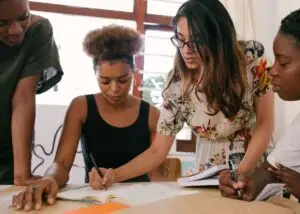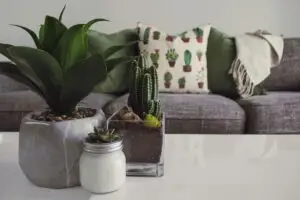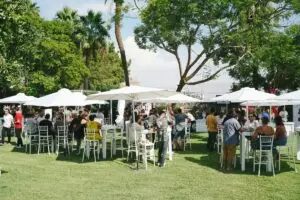How to run a successful panel discussion

In this post, I'll cover:
How to run a successful panel discussion
A panel session is a great addition to your event. A good panel session should be engaging for your audience. It should be interactive and answer any burning questions they might have as well as provide interesting opinions and insights into both sides of a topic from industry experts.
Whether you choose to format just one of your sessions within your agenda as a panel discussion, or it is the format of your whole event, it is important to get it right.
In this post, I’ll cover some simple, practical tips to help you plan and run a successful panel discussion at your next event.
Top tips for selecting the right panellists
Selecting the right panellists for your panel session is vital. Here are some top tips for getting your panel line-up right:
- Select diverse panellists – the whole point of a panel discussion is to create an engaging conversation where panellists discuss their points of view on a particular topic. A successful panel session will have panellists who have different views, opinions and experiences on the question or topic.
- Do your research to check credibility – this sounds like an obvious one, but before you invite someone to take part in a panel discussion, make sure that you have done your research. Review their experience and check that they are credible and a respected person of authority within their field or industry.
- Ask for examples of their public speaking experience – Someone may be a total expert in their field, but if they are not engaging and interesting, or confident with public speaking, then they could make the panel discussion stilted and awkward.
- Make sure the panellists know what is expected of them – Noone likes surprises when it comes to public speaking. Make sure that you share all the information about the panel session before the panellist agrees to come on board. This includes the topics you plan to cover, other panellists and also the content and agenda for the rest of the conference or event. This ensures that they have context and can decide if they are happy to join the discussion.
- Be aware of any existing relationships between panellists – The last thing you want to do is to bring people together on a stage in front of your audience who have previously had a professional disagreement or simply do not get on. Of course, panel sessions are more interesting when differences in opinions are shared, but you want to make sure that it is a healthy, respectful debate between professionals, with no animosity or conflict.
- Choose your moderator carefully – The moderator (or facilitator) is in charge of managing the conversation between the panellists on stage, as well as taking questions from the audience (either live or via an event app). They have a lot to think about and need to be switched on the whole time. They also need to be able to move the conversation along when appropriate, preventing any individuals from dominating the discussion. They also need to be prepared to ask questions of their own if none come from the audience. Your moderator is one of the most important people in your panel discussion. Make sure that it is someone who has experience in the subject matter, who is confident, authoritative, respected and someone who you can trust.
Practical tips for staging a successful panel discussion
In addition to getting the panellists right, there are also several practical elements that you need to consider when organising a panel session for your event:
- Stage layout – You need to take into consideration the layout of your stage when positioning your panel discussion. For example, if you have one large central screen on the stage and your panel discussion takes place in front of that screen, your panellists will be blocking the view of the screen. If you are not planning on showing anything on that screen, except maybe a holding slide during the panel session, then you don’t need to worry as much. However, if you are planning on showing content on the screen, which you are then going to discuss in the panel session, then you cannot place your panellists in front of the screen, and they may need to be placed on either side.
- Live cameras – If you have a large audience, in a big venue, then you may want to consider having live cameras for your panel session. The panel session will be filmed live and projected onto the screens in the room (if you are planning on doing this, make sure that the panellists are not blocking the audience’s view of the screen).
- Seating – Seating is more crucial than you think when staging a successful panel session. Your panellists are going to be in the spotlight, in front of your audience, and they need to feel comfortable. This is not just during the discussion but also arriving and exiting the stage, too. You do not want your chairs to be too low that your panellists sink down into the chair and struggle to get up afterwards. Equally, stools are also a big no-no. Have you ever felt comfortable on a stool? They are unsupportive and if you are shorter, you have to clamber up and jump down which is clunky and for those who wear dresses or skirts, it can feel uncomfortable with the audience at eye-level. Swivel chairs should also be avoided as they often have a mind of their own!
- Provide water – Your panellists will be doing a lot of talking, so make sure that you provide still water for them in a glass. They do not want to be faffing around with opening a bottle. The water should be placed on a table within arm’s reach of each panellist, so if you have several panellists, you will need a couple of tables
How to structure a panel discussion
A good panel session is like a good book – it should have a beginning, middle and end. The key to structuring a successful panel session is to ensure that it is set up correctly, allows adequate time for a good discussion and closes with a succinct summary.
Here are 5 simple steps to help you structure your panel discussion:
- Set the scene – The best way to start a panel discussion is for the moderator to set the scene. They can do this either before or after the panellists have joined them on the stage, but it needs to be before any questions are asked or discussions begin. The moderator needs to introduce each panellist by their full name, title and a short sentence on their experience or area of expertise. They should also provide a summary of what the panel session is about, the topics and how this relates to the purpose of the event.
- Start with pre-approved questions – The moderator should always have a collection of pre-approved questions that they can ask the panel. These are either questions which may have been submitted by the audience throughout the event and approved by the event organiser or questions which are given directly by the event organiser to kick things off. Pre-approved questions not only get the conversation going but can also be shared with the panellists beforehand so that they know what is coming and it makes them feel at ease.
- Questions from the audience – Taking questions from your audience is such an important part of a panel discussion as it engages your audience and brings them into the conversation which is taking place in front of them. Make sure that you have a couple of people available in the audience to take a microphone to anyone asking a question, and your moderator should ask them to wait until a microphone arrives before they ask their question. You can also consider using a catchbox microphone, which is a soft foam ‘ball’ with a microphone in it if you didn’t want to have microphone runners. If you are nervous to have live questions from your audience, consider using an event app or an online platform, such as Slido where your audience can submit questions via their smartphone and you can moderate them in real time.
- Summarize – At the end of the panel discussion, your moderator should provide a summary of the various conversations that have taken place. They should pick out one or two interesting thoughts, observations or takeaways for the audience.
- Thank the panellists – Before the end of the discussion, the moderator should thank each panellist. If relevant, they can also share the contact details / social media handles for each panellist with the audience so they can connect with them after the event.

If you’re looking to add a panel discussion to your next event and are looking for some advice on how best to set this up, get in touch to chat about how my consultancy services could help.



